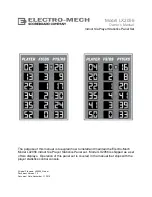
PULSERPLUS PRO™ HIGH RESISTANCE GROUNDING SYSTEM
INSTALLATION, OPERATION AND MAINTENANCE INSTRUCTIONS
4750 Olympic Blvd. • Erlanger, KY 41018 • USA
Phone: 800-537-6144 / 859-283-0778 • Fax: 859-283-2978
www.postglover.com
Serving the Electrical Industry Since 1892
PGR Document #HG111-06
© 2006 Post Glover Resistors, Inc.
PULSERPLUS PRO™ HIGH RESISTANCE GROUNDING SYSTEM
INSTALLATION, OPERATION AND MAINTENANCE INSTRUCTIONS
© 2006 Post Glover Resistors, Inc.
18
Section 7 – Locate a Ground Fault
To locate a ground fault, activate the pulsing circuit by pressing and holding the PULSE pushbutton on the
operator’s panel. Once the words “Pulser On” are indicated on the alphanumeric display, the button may be
released. This activates a control circuit which causes a cyclic switching sequence. The switching sequence
consists of the cycle timing of an integral pulsing relay (P). The pulsing relay (P) output contact on the controller
alternately energizes and de-energizes a pulsing contactor (PX) mounted on the PulserPlus Pro™ control panel
backplate. The pulsing contactor (PX) shorts out a portion of the grounding resistor (NGR) each time the contactor
is energized, producing a tracer signal.
The optional portable hook-on detector is then used to follow the tracer signal through the system to the point of
the fault. The detector is clamped around all three phases of each individual feeder (see Figure 2 below). The
feeder with the fault will show rhythmic fluctuations on the detector’s readout. The fault can be traced to the
sub-feeder and eventually to the faulted device. Once this location is determined, the pulser should be turned
off by pressing and holding the PULSE pushbutton on the operator’s panel. Once the words “Pulser Off” are
indicated on the alphanumeric display, the button may be released.
After clearing the fault, place the system in its normal operation mode by pressing the RESET pushbutton.
Figure 2
How to Locate a Ground Fault







































